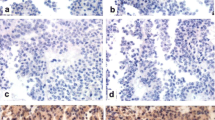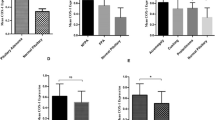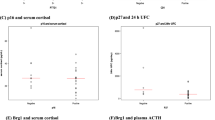Abstract
Cytokines’ involvement in tumorigenesis has been hypothesized. Interleukin-22 (IL-22) is implicated in proliferative and anti-apoptotic pathways via its receptor IL-22R. Its role in pituitary adenomas has never been investigated. Twenty-seven patients with pituitary macroadenomas (PA, 21 males, mean age 53.8 ± 14.4 years) and 30 healthy controls (19 males, mean age 50.4 ± 8.4 years) were enrolled. Out of 27 PA patients, 17 had a non-functioning tumour (NFPA) and 10 a PRL-secreting adenoma (PRL-oma). Serum IL-22 levels were measured in both patients and controls. Immunohistochemical (IHC) tumoral IL-22R expression was evaluated in 10 patients with NFPA and 4 with PRL-oma. IL-22 levels were significantly higher in PA patients than in controls [32.47 (11.29–70.12) vs. 5.58 (0.19–21.46) pg/mL, p < 0.0001] but did not correlate with tumor maximum diameter and were not associated to pituitary function impairment. PRL-oma patients had significantly higher IL-22 levels than NFPA patients [37.18 (14.82–70.12) vs. 21.29 (11.29–56) pg/mL, p = 0.039]. IHC revealed a strong IL-22R staining in 100 % of PRL-omas and 60 % of NFPAs. We provide the first evidence of increased serum IL-22 levels in patients with pituitary macroadenoma, especially in PRL-omas, regardless of tumor size and/or degree of pituitary function impairment. We also demonstrated the expression of IL22R in all PRL-omas and in 60 % of NFPAs.


Similar content being viewed by others
References
Daly AF, Tichomirowa MA, Beckers A (2009) The epidemiology and genetics of pituitary adenomas. Best Pract Res Clin Endocrinol Metab 23:543–554
Melmed S (2011) Pathogenesis of pituitary tumors. Nat Rev Endocrinol 7(5):257–266
Renner U, Paez-Pereda M, Arzt E, Stalla GK (2004) Growth factors and cytokines: function and molecular regulation in pituitary adenomas. Front Horm Res 32:96–109
Vindeløv SD, Hartoft-Nielsen ML, Rasmussen ÅK, Bendtzen K, Kosteljanetz M, Andersson AM, Feldt-Rasmussen U (2011) Interleukin-8 production from human somatotroph adenoma cells is stimulated by interleukin-1β and inhibited by growth hormone releasing hormone and somatostatin. Growth Horm IGF Res 21(3):134–139
Qiu L, He D, Fan X, Li Z, Liao C, Zhu Y, Wang H (2011) The expression of interleukin (IL)-17 and IL-17 receptor and MMP-9 in human pituitary adenomas. Pituitary 4(3):266–275
Wolk K, Witte E, Witte K, Warszawska K, Sabat R (2010) Biology of interleukin-22. Semin Immunopathol 32(1):17–31
Zenewicz LA, Flavell RA (2011) Recent advances in IL-22 biology. Int Immunol 23(3):159–163
Lyakh L, Trinchieri G, Provezza L, Carra G, Gerosa F (2008) Regulation of interleukin-12/interleukin-23 production and T-helper 17 response in humans. Immunol Rev 226:112–131
Dietrich C, Kaina B (2010) The aryl hydrocarbon receptor (AhR) in the regulation of cell–cell contact and tumor growth. Carcinogenesis 31(8):1319–1328
Jaffrain-Rea ML, Angelini M, Gargano D, Tichomirowa MA, Daly AF, Vanbellinghen JF, D’Innocenzo E, Barlier A, Giangaspero F, Esposito V, Ventura L, Arcella A, Theodoropoulou M, Naves LA, Fajardo C, Zacharieva S, Rohmer V, Brue T, Gulino A, Cantore G, Alesse E, Beckers A (2009) Expression of aryl hydrocarbon receptor (AHR) and AHR-interacting protein in pituitary adenomas: pathological and clinical implications. Endocr Relat Cancer 16(3):1029–1043
Pesatori AC, Baccarelli A, Consonni D, Lania A, Beck-Peccoz P, Bertazzi PA, Spada A (2008) Aryl hydrocarbon receptor-interacting protein and pituitary adenomas: a population-based study on subjects exposed to dioxin after the Seveso, Italy, accident. Eur J Endocrinol 159(6):699–703
Cannavò S, Ferraù F, Ragonese M, Curtò L, Torre ML, Magistri M, Marchese A, Alibrandi A, Trimarchi F (2010) Increased prevalence of acromegaly in a highly polluted area. Eur J Endocrinol 163(4):509–513
Renner U, De Santana EC, Gerez J, Fröhlich B, Haedo M, Pereda MP, Onofri C, Stalla GK, Arzt E (2009) Intrapituitary expression and regulation of the gp130 cytokine interleukin-6 and its implication in pituitary physiology and pathophysiology. Ann N Y Acad Sci 1153:89–97
Giacomini D, Acuña M, Gerez J, Nagashima AC, Silberstein S, Páez-Pereda M, Labeur M, Theodoropoulou M, Renner U, Stalla GK, Arzt E (2007) Pituitary action of cytokines: focus on BMP-4 and gp130 family. Neuroendocrinology 85(2):94–100
Haedo MR, Gerez J, Fuertes M, Giacomini D, Páez-Pereda M, Labeur M, Renner U, Stalla GK, Arzt E (2009) Regulation of pituitary function by cytokines. Horm Res 72(5):266–274
Paoletta A, Arnaldi G, Papa R, Boscaro M, Tirabassi G (2011) Intrapituitary cytokines in Cushing’s disease: do they play a role? Pituitary 14(3):236–241
Gangemi S, Minciullo P, Adamo B, Franchina T, Ricciardi GR, Ferraro M, Briguglio R, Toscano G, Saitta S, Adamo V (2012) Clinical significante of circulating interleukin-23 as a prognostic factor in breast cancer patients. J Cell Biochem 113(6):2122–2125
Adamo V, Franchina T, Minciullo PL, Pace E, Colonese F, Ricciardi GR, Saitta S, Ferraro M, Spatari G, Gangemi S (2011) Role of interleukin-23 circulating levels increase in resected colorectal cancer before and after chemotherapy: preliminary data and future perspectives. J Cell Physiol 226(11):3032–3034
Acknowledgments
The authors declare that they have no conflict of interest and they did not receive any financial benefit from research in this study. This study was not supported by grants or funds.
Author information
Authors and Affiliations
Corresponding author
Rights and permissions
About this article
Cite this article
Cannavo, S., Ferrau, F., Cotta, O.R. et al. Increased serum interleukin-22 levels in patients with PRL-secreting and non-functioning pituitary macroadenomas. Pituitary 17, 76–80 (2014). https://doi.org/10.1007/s11102-013-0468-2
Published:
Issue Date:
DOI: https://doi.org/10.1007/s11102-013-0468-2




